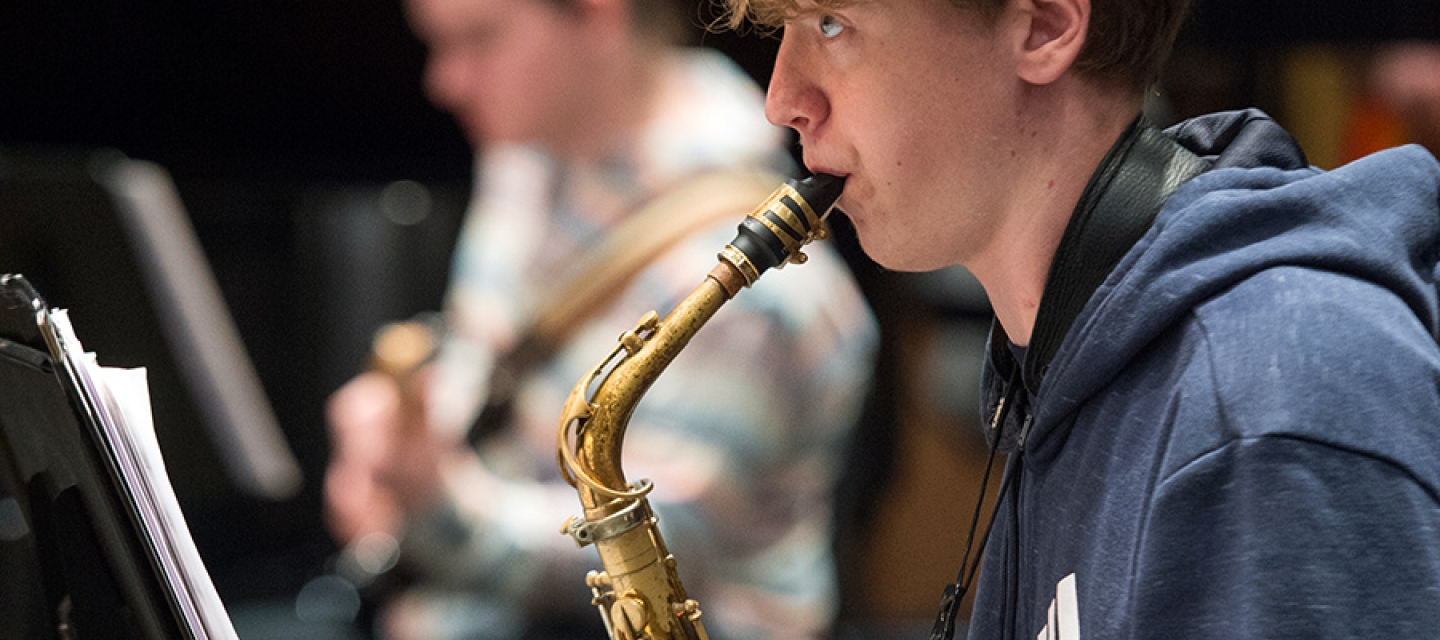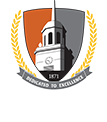
Audition In-Person or with Online Video
All students who audition are automatically considered for Music Department scholarships.
In-Person Auditions
Schedule Your Audition*:
*Auditions begin at 1 p.m.
Online Video Auditions
Auditions are ongoing throughout the 2022-2023 school year
Deadlines
Spring 2023: December 31, 2022
Fall 2023: April 15, 2023
Steps to Your Audition
Apply to Buffalo State (early!)
The Music Department receives many more applications than we are able to admit.
Practice, Practice, Practice!
Take a look at the audition requirements and select pieces to perform at your audition. We suggest selecting pieces with your music teacher’s help. Practice your pieces until they are performance ready. You may also be asked to sight-read during your audition.
Audition
Choice 1: Submit an Online Video Audition
See Online Video Audition Guidelines
Choice 2: Register for Your In-Person Audition
Interview and Essay
Interview: All students will be interviewed by members of the music department faculty for admission to the department. Interviews will happen at the time of the live virtual audition, or will be scheduled individually with students who submit an online auditin video.
Essay: All applicants must provide a prepared essay about their most influential teacher. This person does not have to be a music teacher, but needs to be a person who has had a profound influence on your life. Describe your relationship with this person and why this person has been a positive role model, guide, and inspiration, mentioning emorable characteristics and educational experiences.
Essay Formatting
Length: 500-750 words Font size: 12 Spacing: Double
Prepare for Theory and Ear Training Diagnostic Exams
Students will be given diagnostic tests in Music Theory and Ear Training upon arrival to campus. These exams are meant to help us place you in the appropriate level of each course. Your admission to the music department will not be affected by your performance on the diagnostic exams; however, the results of the exams may impact degree-completion time. All incoming students are encouraged to review the Music Theory Study Guide and the Aural Perceptions Study Guide prior to taking the diagnostic exams.
Your Audition
Audition Day
After your arrival, you will be directed to a practice room. At audition time, you will be led to your audition room by a current student. Following your audition, you will be taken to your interview. After completing both your audition and interview, you are done for the day.
Accompanist Requirements
Instrumentalists are not required to perform with an accompanist.
Vocalists should perform with their own live accompanist, or with a recorded accompaniment for online video auditions. Vocalists will be provided an accompanist for on-campus auditions. Please contact Dr. Holly Bewlay.
Music Theory and Ear-Training
Skills Assessment
Music Theory and Ear-Training will be assessed during orientation and advisement.
Music Theory and Ear-Training Diagnostic Exams
Music Theory and Ear-Training diagnostic exams are held during orientation. For First-Year students, this happens during the week prior to the start of classes. Transfer Students will be tested when they come for advisement during the summer.
Online Video Audition Guidelines
1. Please read the Brass Repertoire Suggestions for their instrument before recording their audition. Choose either two contrasting movements (fast and slow) or a solo and a contrasting etude.
- Recordings should be no longer than 10 minutes and should feature video and audio.
- A recording from a smart phone or computer is sufficient.
2. All brass (trumpets, trombones, euphoniums, tubas, and horns) should be prepared play the concert B flat, F, and E flat scales two octave. You should also be prepared to play the chromatic scale starting on concert b flat two octaves.
3. For recordings: the camera should be set up with an angle that shows your both your embouchure and hand positions. Do not play directly into the microphone.
4. Announce your name and the title/composer of your piece along with the movements that you are going to play.
5. Please generate a “Sharable Link” to your videos. Make sure that settings allow us to view the video using the link. (best to post them on YouTube as an “unlisted” link)
6. Complete the Online Audition Application (LINK) and submit the link to your videos.
7. You will receive a response from the Music Department within 1-2 weeks.
1. Students should read the Guitar Repertoire Suggestions before recording their audition. Choose either two contrasting movements (fast and slow) or a solo and a contrasting etude. Recordings should be no longer than 10-15 minutes and should feature video and audio. A recording from a smart phone or computer is sufficient.
2. Guitarist may use a Steel-Stringed (“Acoustic”) guitar, Electric guitar or Nylon stringed guitars in their audition videos but will be expected to enter the admitting academic year with a nylon string guitar.
3. Play Two (2) Major and Minor scales. One(1) Scale from a key containing sharps(#) and the other scale from a key containing flats (b). The scale form is up to the applicant but the Segovia “Diatonic Major and Minor scales” form is the preferred formed.
4. As you are recording your audition materials please follow these production guidelines:
• The camera should be set up at an angle and distance that clearly instrument placement, both of your hands positioned on the instrument, and a clear framing of your posture in your Audition Video. Please do not play directly into the microphone.
• Before each piece/etude/study/scale/excerpt, please clearly announce your name and the proper title/composer of the work you are recording for this auditioning video. Please make sure to include any relevant work/piece information at this time and make sure that you announce all the movements that you will be recording.
5. Once you have recorded an audition video that best represents your talents and work, please then generate a “Sharable Link” to your videos. Make sure that settings allow us to view the video using the link. (best to post them on YouTube as an “unlisted” link)
6. Complete the Online Audition Application (LINK) and submit the link to your videos.
7. You will receive a response from the Music Department within 1-2 weeks.
1. Students should read the Percussion Repertoire Suggestions for their instrument before recording their audition. Recordings should be no longer than 10 minutes.
2. Percussion Requirements: (please contact Dr. Furby if you do not have access to instruments upon which to record)
• Snare Drum: Solo or etude of choice
• Mallets: Two or four mallet solo of choice on marimba, vibraphone or xylophone.
**Play 3 octaves ascending and descending of the D Major and minor scales and arpeggios of the tonic major and minor triad.
• Timpani: Solo or etude of choice
3. Video recordings:
The camera should be set up with an angle that shows your both your posture and hand positions. Please do not play directly into the microphone. All videos should have no editing, however, percussionists may record a video of
each instrument separately.
4. Announce your name and the title/composer of your piece along with the movements that you are going to play.
5. Please generate a “Sharable Link” to your videos. Make sure that settings allow us to view the video using the link. (best to post them on YouTube as an “unlisted” link)
6. Complete the Online Audition Application (LINK) and submit the link to your videos.
7. You will receive a response from the Music Department within 1-2 weeks.
1. Review the Piano Audition Repertoire Requirements or contact Dr. Boyce if you have any questions about your audition repertoire.
Note: No scales are required for the piano audition. Regardless of your experience with scales, all piano students complete a 4-8 semester sequence of scales and arpeggios depending on your degree program.
2. Set up your camera (the camera on your phone, tablet, or computer is fine to use) so that we can see your sitting position and your hands. A profile view is best.
3. When you start the recording, please announce your name and your pieces.
4. Once you’re done recording your pieces, upload them to YouTube, Google Drive, or a video platform from which you can share your video.
5. Generate a “Sharable Link” to your videos. Make sure that settings allow us to view the video using the link.
6. Complete the Online Audition Application (LINK) and submit the link to your
videos.
7. You will receive a response from the Music Department within 1-2 weeks.
1. Students should read the String Repertoire Suggestions for their instrument before recording their audition. Choose either two contrasting movements (fast and slow) or a solo and a contrasting etude. Recordings should be no
longer than 10 minutes.
2. Violin, viola, and cello students should prepare either one 3-octave major scale or two 2-octave major scales, one of which should show a shift above 1st position (such as C or D major) Double bass students should prepare one octave of the following three major scales: G, D, Eb
3. For recordings, the camera angle should show both the left hand and the entire length of the bow stroke.
4. Announce your name and the title/composer of your piece along with the movements that you are going to play.
5. Please generate a “Sharable Link” to your videos. Make sure that settings allow us to view the video using the link. (best to post them on YouTube as an “unlisted” link)
6. Complete the Online Audition Application (LINK) and submit the link to your videos.
7. You will receive a response from the Music Department within 1-2 weeks.
1. Students should read the Voice Repertoire Suggestions before recording their audition. Recordings should be no longer than 10-15 minutes.
2. If you do not have access to live accompaniment please contact Dr. Holly Bewlay at bewlayhe@buffalostate.edu and she will work with you to secure access to recordings for the accompaniment for your selections.
3. Video recordings:
The camera should be set up with an angle that shows your both your posture and clearly shows your face. Please do not sing directly into the microphone. All videos should have no editing, and students should move from piece to
piece without turning off the camera.
4. Announce your name and the title/composer of each piece prior to beginning each piece.
5. Please generate a “Sharable Link” to your videos. Make sure that settings allow us to view the video using the link. (best to post them on YouTube as an “unlisted” link)
6. Complete the Online Audition Application (LINK) and submit the link to your videos.
7. You will receive a response from the Music Department within 1-2 weeks.
1. Students should read the Woodwind Repertoire Suggestions for their instrument before recording their audition. Choose either two contrasting movements (fast and slow) or a solo and a contrasting etude. Recordings should be no longer than 10 minutes.
2. Woodwinds should all perform scales for your instruments below:
Flute, Chromatic scale C 2 octaves (3 even better) and 2 octave A major and Eb major scales. Oboe, E-flat and F major scales 2 octaves Clarinet, F major (three octaves) and C minor (melodic minor, two octaves) and a 3-octave chromatic scale from E-E Bassoon, 3 octave chromatic scale, low B-flat to high b-flat, 2 octave scales: F and A major Saxophone- 2 octave B-flat chromatic scale, 2 octave E-flat and B major scales
3. For recordings, the camera should be set up with an angle that shows your both your embouchure and hand positions.
4. Announce your name and the title/composer of your piece along with the movements that you are going to play.
5. Please generate a “Sharable Link” to your videos. Make sure that settings allow us to view the video using the link. (best to post them on YouTube as an “unlisted” link)
6. Complete the Online Audition Application (LINK) and submit the link to your videos.
7. You will receive a response from the Music Department within 1-2 weeks.

